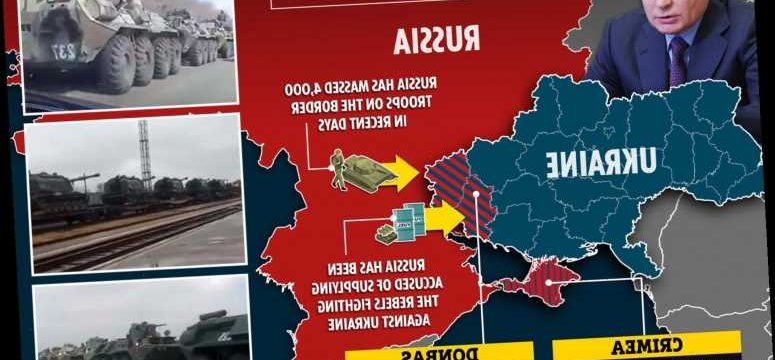RUSSIA has said Ukraine’s plea for help from Nato in the face of its military build-up on their border will “worsen” tensions.
Fears are mounting the simmering conflict between the two countries could erupt into all-out war with Vladimir Putin's army within weeks as Russia masses troops on the border.
Putin has deployed up to 4,000 soldiers along with tanks and other armoured vehicles to the disputed Donbass area, a Russian speaking area which broke away from Ukraine in 2014.
Ukraine’s President Volodymyr Zelenskiy has pleaded with Nato to be allowed to join the alliance, which pledges to come to a member’s aid if one of them is attacked.
But Kremlin spokesman Dmitry Peskov said NATO membership for Ukraine would not resolve the conflict.
"We very much doubt that this will help Ukraine settle its domestic problem," Peskov said.
"From our point of view, it will only worsen the situation.”
The reports of a Russian build-up come amid a dramatic increase in clashes along the frontline in recent weeks.
At least 23 Ukrainian soldiers have been killed since the start of the year, compared to 50 in all of 2020.
Earlier this week, Russian military analyst Pavel Felgenhauer said it now requires a “psychoanalyst” to determine Moscow’s intentions but warned events could see “war in a month”.
He said the West is right to be concerned as unverified footage appears to show military movements in Russia’s Voronezh, Rostov and Krasnodar regions, along with key railway routes.
“The crisis has the potential to escalate into a pan-European war, if not even a world one,” Felgenhauer warned starkly in an interview with Rosbalt news outlet in Russia.
Nato Secretary General Jens Stoltenberg he hgad called Zelensky "to express serious concern about Russia's military activities in and around Ukraine and ongoing ceasefire violations".
What is happening between Russia and Ukraine?
RUSSIA and the Ukraine have remained technically at war since 2014.
Ukraine was aligned with Russia as part of the Soviet Union until its collapse in 1991, following which it became an independent state.
Both nations remained closely tied – but Ukraine gradually began to distance itself, seeking deeper ties with the West.
The open conflict was triggered by the Ukrainian Revolution in 2014 – when an uprising overthrew the pro-Russian government of Viktor Yanukovych.
Vladimir Putin's forces reacted by annexing the region of Crimea from Ukraine – a move which was widely condemned by the West.
The conflict then spiralled when pro-Russian groups in Eastern Ukraine then took up arms against the state.
Russia gave their backing the separatist forces which formed breakaway republics in Donetsk and Luhansk.
Putin's forces then launched a military incursion into these regions as they gave their support to the rebels.
Russia continues to hold Crimea – and claims the region joined them willingly after they a referendum.
Almost seven years have now passed and the War in Donbass remains at a stalemate.
It is estimated some 14,000 have been killed in the conflict, including more than 3,00 civilians.
Ukraine and the rebels signed a new ceasefire in July 2020 – but clashes have been steadily increasing again since last November.
"NATO firmly supports Ukraine's sovereignty and territorial integrity. We remain committed to our close partnership," he said.
The United States and Britain have expressed their solidarity, with the Pentagon last week saying US forces in Europe had raised their alert status.
The Donbass conflict erupted in the months after Russian forces seized Ukraine's Crimean peninsula in 2014.
Ukraine and Western countries says Donbass separatists have been armed, led, funded and aided by Russians, including active Russian troops. Moscow has denied interfering.
While a ceasefire halted full-scale warfare in 2015, sporadic deadly fighting never ceased.
Ukraine's ground forces meanwhile announced 10 days of exercises for 600 reservists in the south of the country.
Source: Read Full Article







